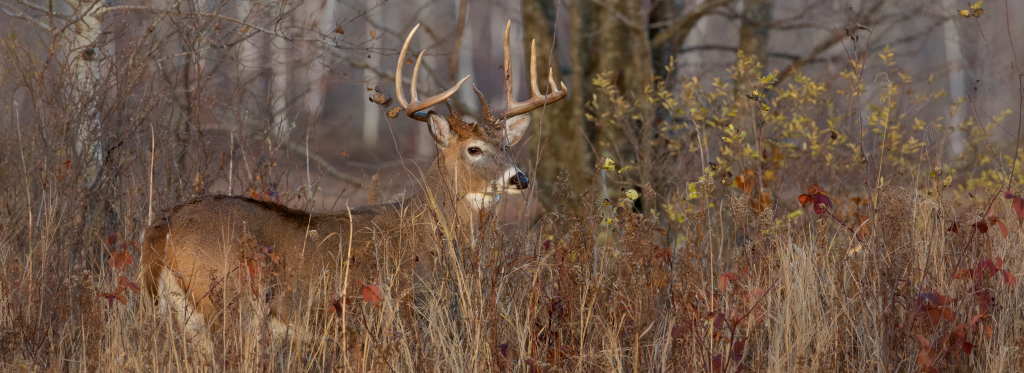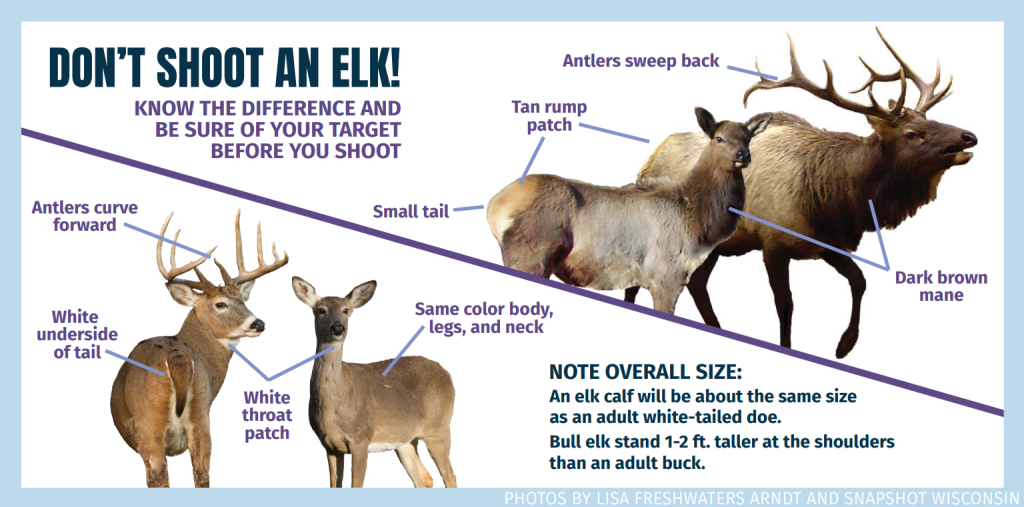Deer hunting
Season Dates, Regulations and Hours
Nationally recognized as one of the country's premier states for hunting white-tailed deer, Wisconsin has both an abundant herd and a reputation for producing some of the largest bucks in the world. Hunters have several opportunities this fall.
2025 Season Dates
| Archery and Crossbow* | Sept. 13 - Jan. 4, 2026 |
| Youth Deer Hunt | Oct. 11-12 |
| Gun Deer Hunt for Hunters with Disabilities** | Oct. 4-12 |
| Gun | Nov. 22 - 30 |
| Muzzleloader | Dec. 1-10 |
| Statewide Antlerless-only | Dec. 11-14 |
| Antlerless-only Holiday Hunt*** | Dec. 24 - Jan. 1, 2026 |
* Season continues until Jan. 31, 2026, in Metro subunits and select Farmland Counties.
** This is not a statewide season. More information is available at the DNR's Deer Hunting For Hunters With Disabilities webpage.
*** Open only in select DMUs; see regulations for open counties.
Regulations
All deer hunting regulations can be found on the Hunting Regulations webpage.
Additionally, hunters should often refer to the Baiting and Feeding Regulations webpage to determine if their county allows deer to be baited and fed. The Carcass Movement, Processing and Disposal webpage also has good information on how and where deer can be moved.
Hours
Hunting hours differ depending on the location in the state. Hunters can use the following documents to check hunting hours for the part of the state they hunt.
Purchase A Hunting License
Wisconsin has made it easy to buy licenses and registrations. Hunters can purchase deer licenses and bonus authorizations through the Go Wild app or at license sale locations.
Antlerless Harvest Authorizations
Bonus antlerless harvest authorizations will be available for purchase starting Aug. 18 through the Go Wild app or at any license sale locations.
These bonus antlerless harvest authorizations may be filled with any weapon type during the appropriate season. They must be filled in the zone, unit and land type (public or private) designated on each harvest authorization. Bonus antlerless harvest authorizations are available on a first-come, first-served basis for $12 each for residents, $20 each for nonresidents and $5 for youth hunters under age 12.
One to five additional Farmland antlerless harvest authorizations will be included in 2025 with each deer hunting license, depending on the unit of choice.
Unsure which Deer Management Unit (DMU) to select? A new DMU layer has been added to the Public Access Lands mapping application. If the DMU boundaries don't show up when you click the prior link, you may need to select the DMU layer. To do so, open the app and select the "Layers" tab. Under the "Recreational Opportunities" category, enable the "Deer Mgt Units/Zones." Zoom in on the area you plan to hunt in to determine which DMU you fall within. As you zoom in, information on the zone and unit number will appear.
Hunting In Metro Sub-Units
For full details, including county lists and maps of metro sub-units, see the 2025 Metro Sub-unit Guide.
Hunters may use any of their Farmland antlerless deer harvest authorizations included with their license or purchased bonus antlerless deer harvest authorizations to hunt in a metro sub-unit by selecting the deer management unit (DMU) where the sub-unit is located. These harvest authorizations are valid within the entire DMU, including any metro sub-unit within that DMU. Find your DMU using the PAL mapping application.
Hunters may also request a metro sub-unit antlerless deer harvest authorization at no cost or purchase a bonus metro sub-unit antlerless deer harvest authorization. These options are available only in certain counties, and the harvest authorizations are limited to the boundaries of the metro sub-unit selected.
Hunting Programs
The DNR and partner organizations provide ways to learn to hunt or enjoy new experiences this deer hunting season.
First-time Hunters
Anyone can obtain a mentored-only hunting license and hunt without first completing a hunter education course. They must be accompanied by a licensed hunter (mentor), hunt within arm's reach of the mentor and follow other rules. Learn more about Wisconsin's Mentored Hunting Program.
Learn to Hunt programs combine four-plus hours of classroom and field instruction before a novice goes hunting with a qualified mentor. They provide a great opportunity for beginners of all ages and backgrounds to learn how to hunt safely and ethically in Wisconsin.
Youth Deer Hunt
Youth hunters under the age of 16 may hunt deer with a gun in all Deer Management Units except state parks and non-quota units during the Youth Deer Hunt. A gun deer hunting license is required if hunting with a firearm.
Hunters With Disabilities
Thanks to generous landowners sponsoring hunters with disabilities on their land, the Wisconsin Deer Hunt for Hunters with Disabilities continues to grow. Hunters wishing to participate and landowners wanting to open their property can learn more at the DNR's Deer Hunting For Hunters With Disabilities webpage.
Sandhill Wildlife Area
Sandhill Wildlife Area (9,150 acres) is open to the public year-round and hosts many outdoor workshops and wildlife studies. This year, multiple special hunts are happening at Sandhill as part of a research study on deer densities. Apply for one of this year's special hunting opportunities at the Sandhill Wildlife Outdoor Skills webpage.
Active Service Members
Wisconsin law extends specific permit and licensure privileges to active members of the U.S. Armed Forces.
Apostle Islands National Lakeshore Hunting
There are a number of harvest opportunities available within the lakeshore.
Where To Hunt
Not everyone has access to a "back 40." Luckily, Wisconsin has over seven million acres of open public hunting land across diverse habitats.
Find Properties Open To Public Hunting
With support from the USDA, the DNR partners with private landowners to lease public access to hunting habitats across the Voluntary Public Access (VPA) Program. Additionally, through the Managed Forest Law (MFL) and Forest Crop Law (FCL) programs, private forest lands are open to the public for recreation, including deer hunting.
Hunters can search for their next deer hunting spot through:
- Public land access
- Use this resource to find public land for any outdoor activity, including hunting, fishing, hiking, camping and wildlife viewing.
- Voluntary Public Access Program (VPA)
- Through this program, hundreds of landowners have opened their land to the public for year-round hunting, fishing, trapping and wildlife viewing. Hunters do not need to contact landowners for permission to access these properties.
- Over 30,000 acres of private land are accessible to the public and can be found using the VPA interactive map.
Use the DNR's Public Access Lands Maps to explore public hunting options across the state.
Hunting Safety Tips
Safety should be every hunter's top target each fall.
Remember, at least 50% of each hunter's clothing above the waist must be blaze orange or pink any time there is a firearm deer season in progress, and any head covering must be at least 50% blaze orange or pink.
Make sure to follow the four rules of basic firearm safety – TAB-K.
- T = Treat every firearm as if it is loaded. Never assume a gun is unloaded, and never treat it that way, even if you watch as it is unloaded. Make it a habit to treat guns like they are always loaded.
- A = Always point the muzzle in a safe direction. About one-third of all hunting incidents are self-inflicted injuries. That means the muzzle was pointed at some part of the hunter's body. A safe approach is one where the bullet will travel and harm no one in the event of an unwanted discharge. There are no accidental discharges with firearms, only unwanted discharges.
- B = Be sure of your target and what's beyond it. Positive target identification is a must. To shoot at something you only think is a legal target is gambling. In the case of human injury, that means gambling on human life. You must be specific and correct in judgment before deciding to shoot. Otherwise, it's reckless behavior. In addition to identifying the target, a hunter must know that a safe backstop for their bullet is present in every shooting situation. We don't always hit our target; in some cases, the bullet passes through the target. A safe backstop guarantees that no one will get hurt.
- K = Keep your finger outside the trigger guard until ready to shoot. If a hunter stumbles with a firearm in one hand and nothing in the other, whatever that person does with their free hand will automatically happen with the hand holding the gun. If a finger is inside the trigger guard, that hand will likely close around the gun's pistol grip and on the trigger, causing an unwanted discharge.
Hunter Resources
This fall, get ahead of the game and take advantage of the DNR's resources that help hunters succeed before and after the hunt.
Wild Wisconsin
Hunters interested in learning more about Wisconsin's deer hunting culture, research and tips should watch the Wild Wisconsin web series.
Chronic Wasting Disease (CWD)
Visit the DNR's CWD webpage to learn what hunters can do to slow the spread and how to get your deer tested.
Field Dressing And Butchering Guides
Save this Field Dressing Deer: Pocket Guide for pointers while in the field, and watch the DNR's guide to processing your deer at home.
Don't shoot an elk!
Remember, always be sure of your target!
Deer Donation Program
Wisconsin hunters can give back during the hunting season by donating their deer to help stock food pantries via the DNR's Deer Donation Program to help stock food pantries.
Deer Management
Learn about Wisconsin's Deer Management.
Register A Harvest
Harvested A Deer? Here's What's Next:
- Register your deer through GameReg. Registration is required and must be completed by 5 p.m. the day after the deer carcass is recovered.
- Get your deer tested for Chronic Wasting Disease. CWD testing is not required, but it is recommended. It's also free and easy to do.
- Process your deer and enjoy your venison. However, the Wisconsin Department of Health Services and the Centers for Disease Control recommend against eating venison from deer that have tested positive for CWD.
- Safely dispose of deer carcass waste. Several options are available to safely and legally dispose of deer carcass waste, which can help slow the spread of CWD.
- Commemorate your first harvest. If you or a friend or family member celebrated their first deer harvest this year, request a personalized First Deer Certificate.
Deer Health and Diseases
What is CWD?
Chronic wasting disease (CWD) is a degenerative disease of the brain and nervous tissue that infects white-tailed deer and other cervids. It belongs to the family of diseases known as transmissible spongiform encephalopathies (TSEs) or prion diseases. CWD occurs only in members of the cervid or deer family.
The Wisconsin Department of Natural Resources began monitoring the state's wild white-tailed deer for CWD in 1999. The first positives were found in 2002. While testing a harvested deer is not required, hunters are encouraged to learn about CWD in Wisconsin and stay current on mandatory baiting and feeding restrictions.
Visit the DNR's Chronic Wasting Disease webpage to learn more about how to get your deer tested and help slow the spread.
Deer Management Units
Deer management is done at the unit level by allocating antlerless harvest permits and season dates. Deer Management Units (DMUs) mirror county boundaries in the Central and Southern Farmland zones and are habitat-based in the Northern and Central Forest zones. Metropolitan subunits, islands of the Apostle Islands National Lakeshore and Madeline Island in Ashland County or being within the exterior boundaries of the Bad River, Lac Courte Oreilles, Lac du Flambeau, Menominee and Red Cliff Reservations have separate boundaries. Antlerless deer quotas and authorizations are decided at the DMU level.
The DNR reviews Deer Management Units every three years, utilizing input from the Citizen Deer Advisory Councils (CDACs), legislative hearings, and the public. For more details on this review process, visit the Deer Management page.
- Interactive map of DMU boundaries
- Map of Deer Management Units 2025
- Comparison map of prior and new DMU boundaries
- DMU Boundary Descriptions
Deer Season Structure Maps
- 2025 Deer Management Unit and Season Structure Map
- 2025 Farmland Zone Antlerless Authorizations Per License Map
- For a detailed, interactive map, visit the DNR's Public Access Lands Maps.



